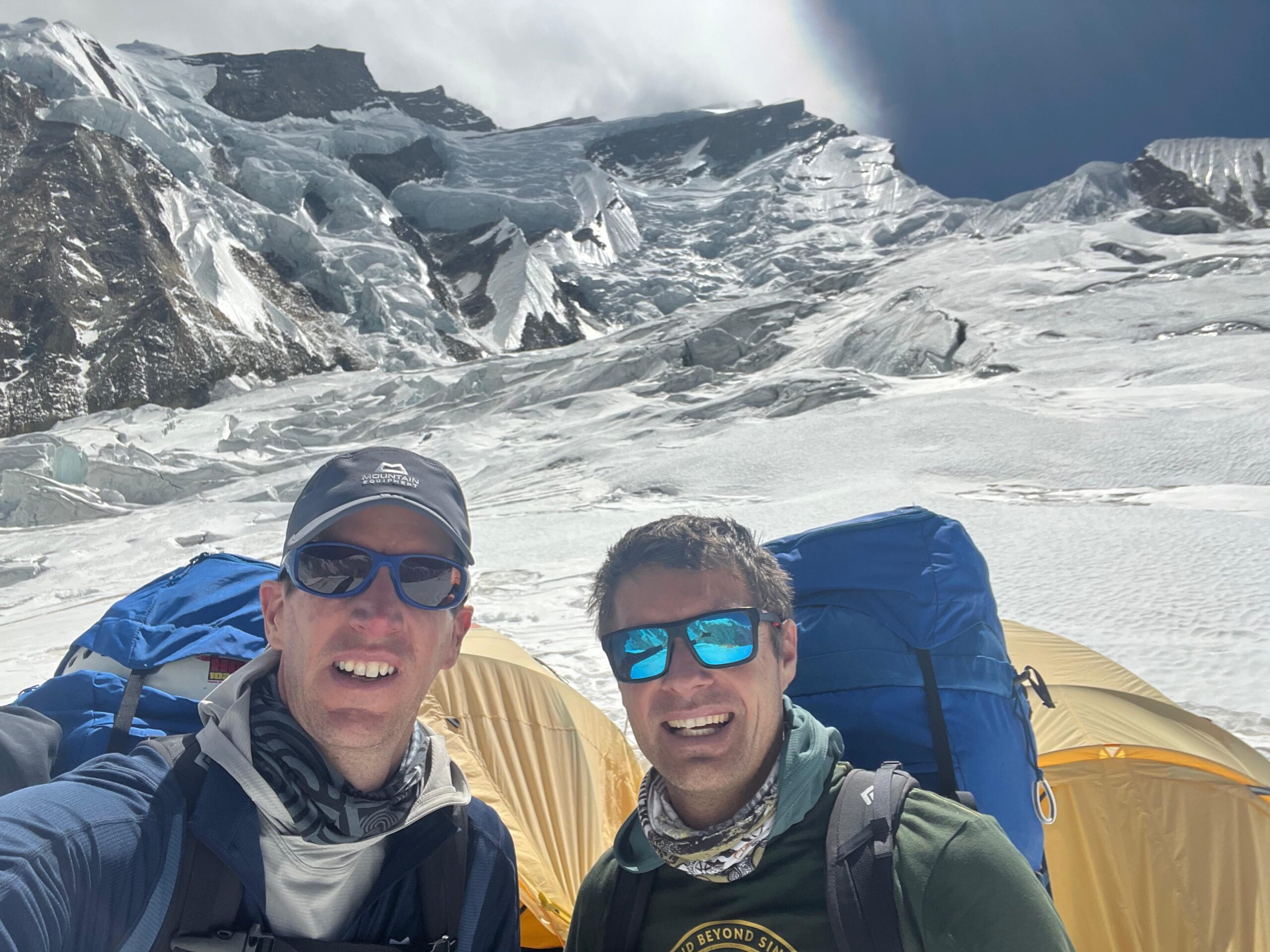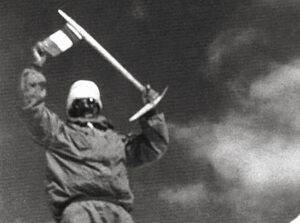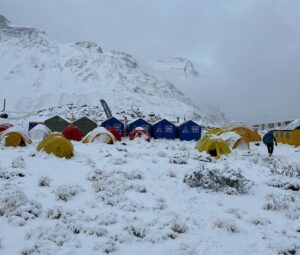Commercialization is here to stay on Annapurna. While resources are optimized and summit rates maximized, there are also worrying trends. There are too many inexperienced climbers, an alarming number of rescues, and local workers are losing their lives.
South African climbers Warren Eva and John Black made time to chat with ExplorersWeb about their experience this season on Annapurna. They discuss crowds, oxygen use, airlifts, and the recent avalanche.
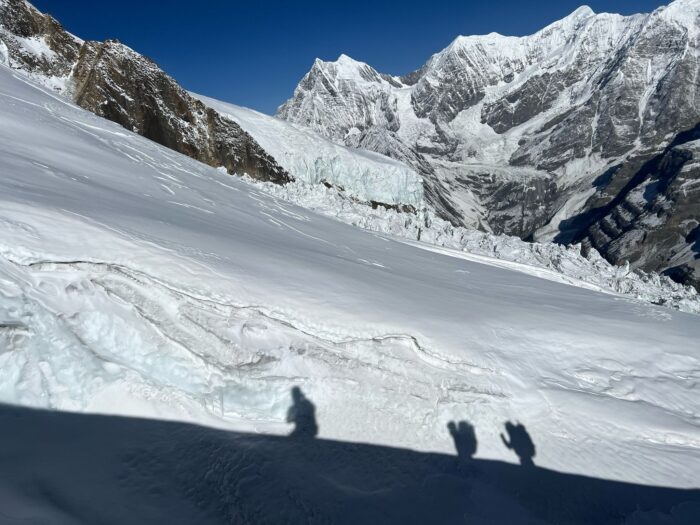
Shadow of climbers on Annapurna. Photo: John Black
Mountaineers and collectors
Eva and Black have been climbing mates for years and have climbed extensively around the world. In 2022, climbing together, they achieved the first South African summits on K2. It was Eva’s first 8,000’er, while Black had climbed Everest back in 2009. They regard the summit as just one part of the climbing experience. They were surprised to find some people in Annapurna Base Camp had very different outlooks.
“I feel some people come to the highest mountains with the single goal of ticking off the summit,” Black said. “I can’t understand how someone can plan a Himalayan expedition and then get helicoptered in and out of Base Camp. The trekking is stunning, with forests and waterfalls and an amazing culture, [it is] an inherent part of the experience,” Eva said.
The two friends planned Annapurna in spring thinking the peak, famed as dangerous and technically demanding, wouldn’t be as crowded as other 8,000’ers in Nepal. They were wrong.
Authorities granted a record number of permits for Annapurna this year, 66 at last count. Nearly 40 people, at least half of them Sherpas, reached the summit on April 6 and 7.
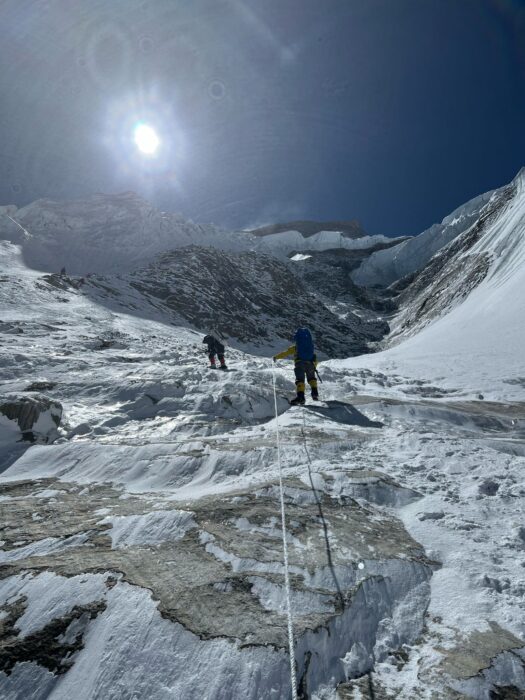
Climbing on a dry Annapurna. Photo: John Black
Eva and Black had planned to stay in Nepal’s mountains for at least two months. On Thursday, they changed their return plane tickets and they will be back home by the end of the week.
Two points of view
Eva and Black took part in the massive summit push launched on April 6. The push began immediately after ropes were fixed to the summit on the third attempt and only four weeks after the rope-fixing team first set foot on the mountain.
Crowding was the least of their problems. While the bulk of climbers were approaching the summit, an avalanche swept the route between Camp 2 and Camp 3, killing two Nepalese climbers. Hours later, SOS calls rolled in from the higher camp, prompting a shocking number of airlifts.
Eva and Black were in different spots at the time. While Eva became the first South African to reach Annapurna’s summit, Black turned around before the summit, took a rest in Camp 3, and then climbed down. Black escaped the deadly avalanche by 15 minutes and then saw the rescues from Base Camp.
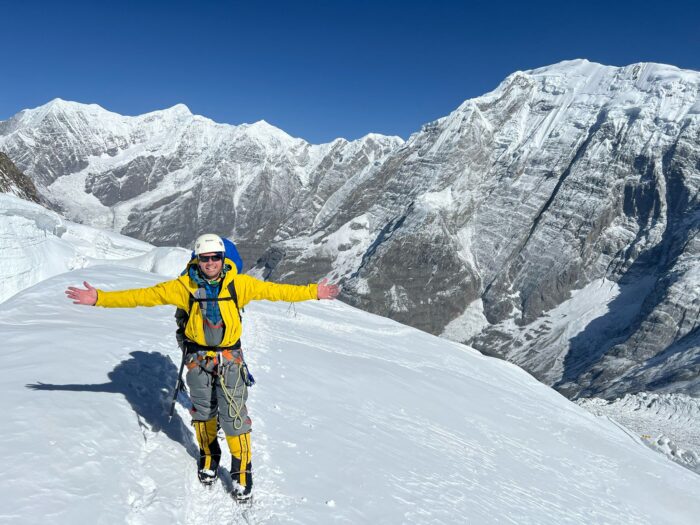
Warren Eva on Annapurna. Photo: John Black
The summit push
Black and Eva departed Camp 3 at around 7 pm on April 6; they were the last to depart.
“Some other groups had left in the afternoon, but we considered it unnecessary. We didn’t want to reach the summit before sunrise,” they explained. Outfitted by Pioneer Adventure, they set off with a supporting Sherpa each and supplementary O2.
“We planned to try without O2, but that plan involved having a Camp 4, which was not there. Doing three acclimatization trips before attempting the summit was not an option for us; the early summit push gave us just enough time for a single rotation, and we didn’t feel well acclimatized,” they said.
Asked about when climbers start using O2 on Annapurna, they said that most people started at Camp 3. However, they saw at least two people with masks on from Camp 2.
“I am not sure whether that is a good idea,” Black said. “While O2 makes you go faster, wearing the mask on the technical sections above Camp 2 is a burden.”
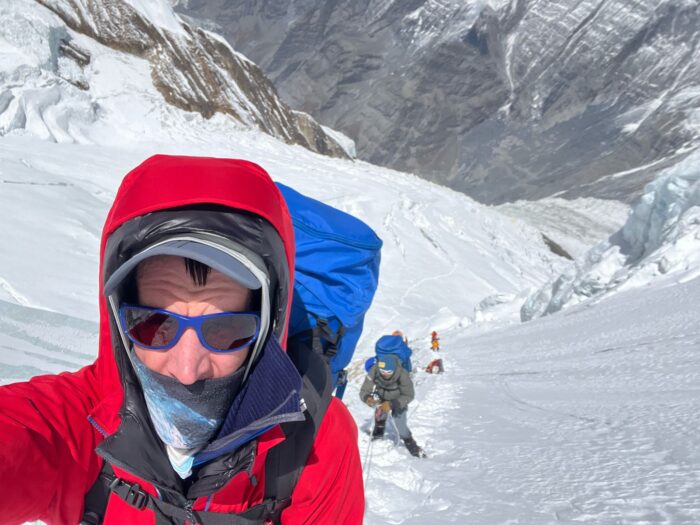
John Black’s selfie while climbing on Annapurna. Photo: John Black
The climbers noted there was a significant number of people on Annapurna with no mountaineering experience.
“We’ll see the summit statistics, but not everyone on the mountain was in condition to attempt the summit,” Eva noted.
Eva’s summit
Shortly after departing on the final push, Black’s progress stalled amongst the crowds.
“I was feeling physically strong and healthy, but mentally unsettled, too aware of my lack of acclimatization. All my thoughts were on the long day and the lack of a Camp 4 that I could have used on the descent if I kept going,” Black said. “It is not that I was in a race or anything, but at high altitude, speed is important. The quicker you move, the less time you are exposed to altitude, potential avalanches, or rockfalls. With that in mind, I had to turn around.”
Black stressed that their tent in Camp 3 was pitched at 6,400m, a whopping 1,700 vertical meters below the summit.
Meanwhile, Eva continued at a good pace with Kaji Sherpa (whom Eva cannot praise enough). Soon they started passing other climbers, and before dawn, they had reached the rope-fixing team. They went across some sections without ropes or used old ropes from previous seasons.
“It was steep but were were confident on that kind of terrain,” Eva said.
Shortly before 9:20 am, Eva and Kaji Sherpa stood on the summit.
“I was surprised how cold it was, colder than I have ever experienced on a mountain,” Eva recalled. “We stood on top for about 10 minutes and then returned to Camp 3, which we reached at about 3 pm.”
Again, they were well ahead of other summiters, some of whom needed several more hours to get back to camp.
Critical hours
Eva agrees moving quickly is essential for Annapurna.
“The peak is not as physically demanding as K2, but the area between Camp 2 and Camp 3 is highly dangerous, and there is very little you can do to avoid that danger other than moving fast,” Eva said.
The same goes for the higher sections, he explains. Eva thinks the 8,000’ers are getting more dangerous because there are more and more people who are not quick enough and spend more time exposed to altitude. Those who can move quickly are, in turn, slowed by the crowds.
A couple of hours of rest at Camp 3 was enough recovery for Eva, who asked Kaji Sherpa to proceed back to Camp 2 that same day. But Kaji Sherpa said they should stay. News of an avalanche was spreading.
“Back in the tent at Camp 3, there were five of us, but that’s okay. I felt warm and safe; content with my summit,” Eva said. Hours later, he heard the sound of helicopters.
Meanwhile, Black had returned to Camp 3 for a rest. On the morning of April 7, he started down with his Sherpa. He heard the avalanche when he was above Camp 2, down the glacier.
At first, it seemed the slide wouldn’t come any closer, but it grew as it fell and he was hit by the snow and ice cloud. You can check out the video he posted on social media here.
“I saw a small group coming down. The avalanche passed right below them and didn’t touch them. I saw them descending but then start going back up, as the ropes were missing, the area was unstable, and there was a potential risk of further avalanches falling on that same place,” Black said.
Indeed, there were other avalanches that day, which put those descending, and the Sherpas trying to locate missing colleagues, in danger.
Unnecessary airlifts?
“In the early morning of April 8, I woke up to a bit of chaos. Two helicopters came between 8 and 8:30 am and evacuated two climbers,” Eva said. He noted that one of the climbers rescued was sick with snow blindness that had developed while ascending from Camp 2 (they hadn’t taken part in the final push).
“Then, there were some long-line rescues. I didn’t stay much longer; I was keen to go down and see John [Black] and tell him about the summit push. However, there were rumors that the route was damaged,” Eva continued.
Fortunately, Sherpas placed new ropes and climbers managed to go down that day.
“The situation was tense, with climbers tired from the summit day before. There were rumors of climbers dead and ropes cut…several people were out of their depth and, this is speculation, but I wonder how many of the airlifts were necessary,” Eva said.
On the morning of April 8, Black got up early to check the situation. He saw two helicopters perform the first two rescues and then counted six or seven long-line rescues that day. He also listened to radio conversations in which people discussed which airlifts were genuinely rescues and covered by the insurance companies, and which would have to be paid for privately.
“Several people who were airlifted from Camp 3 weren’t, in my humble opinion, genuine rescues,” Black said. Eva agreed.
“I am not one to judge people on their decisions [regarding helicopters],” Black said. “What upset me is that I got to the helipad that morning because I was asked to share what I had seen during the avalanche with the brothers of the lost Sherpas who were there. Despite Seven Summit Treks [the deceased Sherpa’s employer] best efforts, I wonder if the helicopters could have searched the mountain faster or more thoroughly if they had not been assigned to rescues that, in some cases, were not that urgent.”
Given the circumstances of the avalanche, Black doesn’t think Rima Sherpa and Gnima Tashi Sherpa could have been saved, but questions about priorities when several SOS calls collide opens a complex debate.
Somber future
Black and Eva shared their concerns about how the situation on 8,000’ers is evolving.
“I am concerned about the crowding. I expected people on Annapurna, but not that many people,” Eva said. “Often, there are not enough anchors to secure the ropes, and it is usual to see several people clipped to the same rope, trying to drag themselves up.”
Another problem is the increasing number of climbers with no previous experience who depend totally on their Sherpa guides.
“It is not my place to say who should be on the mountain and who should not, but there are more and more people going to the 8,000’ers that I wouldn’t classify as mountaineers,” Black said. “The technical skills aren’t there, the rock and ice climbing skills aren’t there, the abseiling skills aren’t there, the skills to manage ropes efficiently aren’t there… some don’t know how to put their crampons on.”
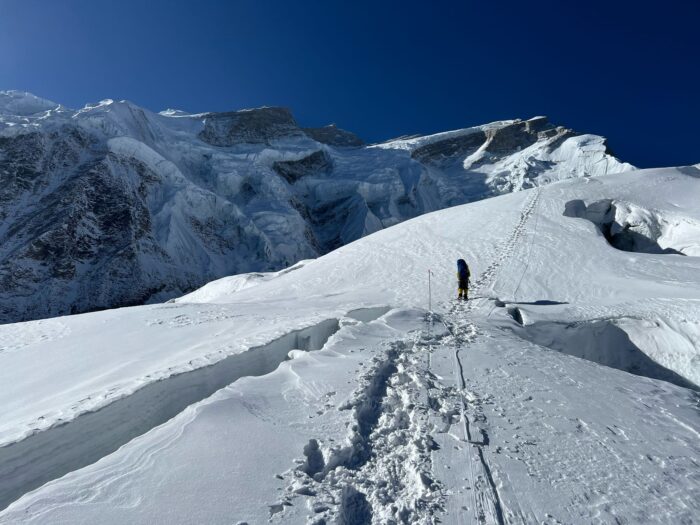
Ropes along a crevasse on Annapurna’s lower sections. Photo: John Black
“It highlights the incredible work of the Sherpa guides and how strong they are,” Eva pointed out. “These people are much more than uniquely adapted to perform at altitude. They manage every aspect of their clients’ climb, and they can compensate for clients who don’t know what they are doing and are unaware of the danger they are in at altitude.”
Eva fears that the thought of a helicopter rescue if anything goes wrong might lead to a false sense of security: “The Sherpas can compensate…to a certain point, but circumstances can take a dramatic turn quickly in the mountains.”
John Black pointed to another potentially troublesome issue: insurance.
“This is probably simplistic, but I can’t help thinking that soon the Himalaya will be almost uninsurable. Climbers and operators will not be able to get the insurance they require upfront because of the ratio between claims and insurance…evacuations are becoming too frequent and too unnecessary,” Black said.
